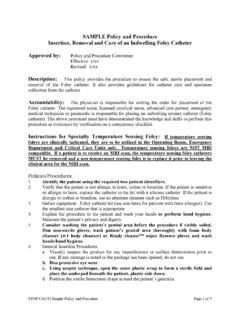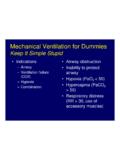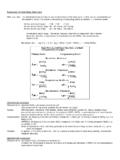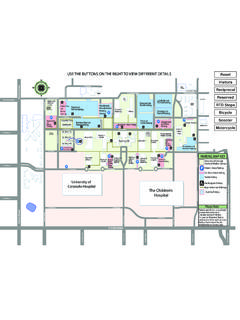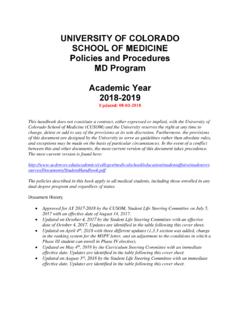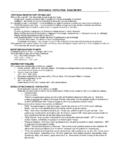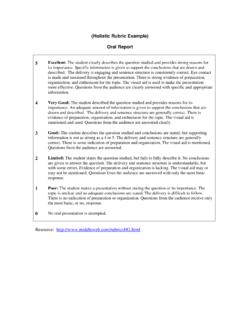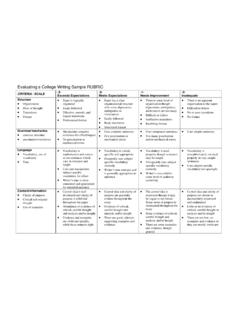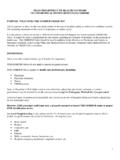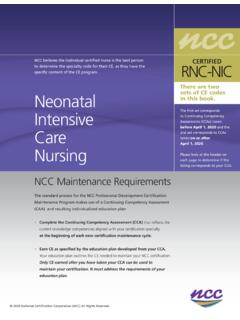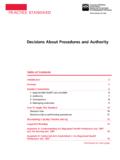Transcription of Fundamentals of Critical Care - Denver, Colorado
1 Fundamentals of Critical care : Hemodynamics, Monitoring, ShockJoshua Goldberg, MDAssistant Professor of SurgeryAssociate Medical Director, Burn UnitUCHSCD efinitions and Principles The measurement and interpretation of biological systems that describe performance of the cardiovascular system Monitoring is NOT therapy Clinicians must know how to interpret the data Very few randomized controlled trialsOxygen Delivery is the GoalOxygen DeliveryDO2 (mL O2 /min) = CO (L/min) x CaO2 (mL O2 /dL) x 10CO (L/min) = HR (beats/min) x SV (L/beat)CaO2 (mL O2 /dL) = [ x (Hb)(g/dL) x SaO2 ] + [.003 x PaO2 mm Hg]Oxygen ConsumptionCVO2 (mL O2 /dL) = [ x (Hb)(g/dL) x SVO2 ] + [.003 x PVO2 mm Hg]VO2 (mL O2 /min) = CO x 3(CaO2 CVO2 ) x 10 Determinants of Cardiac Performance Preload Estimated by end-diastolic volume (pressure) CVP for RVEDV, PAOP (wedge) for LVEDV Afterload SVR = [MAP-CVP]/CO x 80 ContractilityMethods of hemodynamic Monitoring Arterial Blood Pressure Non-invasive Direct arterial pressure measurement Central Venous Pressure The Pulmonary Artery Catheter Cardiac Output Measurement Tissue OxygenationNon-invasive Blood Pressure MonitoringNon-invasive Blood Pressure Measurement Manual or automated devices Method of measurement Oscillometric (most common) MAP most accurate, DP least accurate Auscultatory (Korotkoff sounds)
2 MAP is calculated CombinationLimitations of Non-invasive Blood Pressure Monitoring Cuff must be placed correctly and must be appropriately sized Auscultatory method is very inaccurate Korotkoff sounds difficult to hear Significant underestimation in low-flow ( shock) states Oscillometric measurements also commonly inaccurate (> 5 mm Hg off directly recorded pressures)Direct Arterial Blood Pressure MeasurementIndications for Arterial Catheterization Need for continuous blood pressure measurement hemodynamic instability Vasopressor requirement Respiratory failure Frequent arterial blood gas assessments Most common locations: radial, femoral, axillary, and dorsalis pedisComplications of Arterial Catheterization Hemorrhage Hematoma Thrombosis Proximal or distal embolization Pseudoaneurysm InfectionPseudoaneurysmLimitations of Arterial Catheterization Pressure does not accurately reflect flow when vascular impedance is abnormal Systolic pressure amplification Mean pressure is more accurate Recording artifacts Underdamping OverdampingWaveform DistortionCentral Venous Catheterization Central venous pressure Right atrial (superior vena cava) pressure Limited by respiratory variation and PEEP Central venous oxygen saturation SCVO2 Correlates with SMVO2 assuming stable cardiac function Goal-directed resuscitation in severe sepsis and septic shock (Rivers, et al)
3 Central Venous Pressure WaveformThe Pulmonary Artery Catheter HJC Swan and Santa Monica Bay sailboats (NEJM 1970) Widespread use in critically ill patients Remains controversial Lack of prospective, randomized trials PAC data are only as good as the clinicians interpretation and application Measures CVP, PAP, PAOP, Cardiac Index and SVO2 Approximately 1 million PACs placed annuallyPulmonary Artery CatheterIndications for Pulmonary Artery Catheterization Identification of the type of shock Cardiogenic (acute MI) Hypovolemic (hemorrhagic) Obstructive (PE, cardiac tamponade) Distributive (septic) Many critically ill patients exhibit elements of more than 1 shock classification Monitoring the effectiveness of therapyNormal hemodynamic ValuesSVO260-75%Stroke volume50-100 mLStroke index25-45 mL/M2 Cardiac output4-8 L/minCardiac L/min/M2 MAP60-100 mm HgCVP2-6 mm HgPAP systolic20-30 mm HgPAP diastolic5-15 mm HgPAOP (wedge)8-12 mm HgSVR900-1300 Profiles in ShockClass of ShockCVPPAOPCO/CISVRC ardiogenicHypovolemicHyperdynamic septicHypodynamic septicPulmonary Artery Catheter PlacementComplications of Pulmonary Artery Catheterization General central line complications Pneumothorax Arterial injury Infection Embolization Inability to place PAC into PA Arrhythmias (heart block)
4 Pulmonary artery ruptureThe Pulmonary Artery Catheter Controversy Accuracy of data affected by many conditions common in critically ill patients Lack of prospective randomized data supporting better outcomes with PAC Lack of consensus about goals of therapy Paucity of standard guidelines for use Limited by the ability of the clinician to accurately interpret PAC dataPAC-directed Supranormal Hemodynamics in Surgical Patients Prospective trial by Shoemaker, et al Observed that among high-risk surgical patients, survivors demonstrated supranormal hemodynamics 88 patients randomized to: CVP-control group PAC-control group (goal was normal hemodynamics and oxygen transport) PAC-protocol group (goal was supranormal hemodynamics and oxygen transport) Mortality benefit in PAC-protocol groupChest 1988;94.
5 1176-1186 PAC for Goal-Directed Therapy in High-Risk Surgical Patients NEJM January 2003 [348(1):5-14] RCT by Canadian Critical care Clinical Trials Group 1994 patients, 60 or older, ASA III/IV, required ICU post-op No mortality benefit, No days of hospitalization benefit Higher rate of pulmonary embolism in PAC groupMeta-analysis of Randomized Clinical Trials of PACs JAMA October 2005 [294(13): 1664-1670] 5051 patients in 13 RCTs 8 RCTs (2667) were surgical patients 3 RCTs (910) were sepsis/ARDS patients Results: No significant change in mortality with PAC No significant change in days of hospitalization with PACQ uickTime and a decompressorare needed to see this 2005;294(13):1664-1670 QuickTime and a decompressorare needed to see this 2005;294(13):1664-1670 Cardiac Output Measurement Multiple techniques Thermodilution most common Transpulmonary Pulse contour analysis Esophageal Doppler Newer pulmonary artery catheters offer continuous cardiac output measurementThermodilution Method of Cardiac Output MeasurementTissue Oxygenation Despite advances, our ability to monitor the microcirculation and tissue perfusion is limited Laboratory tests for metabolic acidosis are global and insensitive Newer technology on the horizon Gastric tonometry Sublingual capnometryShock The rude unhinging of the machinery of life - Henry Gross, 1872 End-organ cellular dysfunction due to tissue hypoperfusion Types Hypovolemic (hemorrhagic) Cardiogenic (myocardial infarction) Distributive (septic, neurogenic, anaphylactic)
6 Obstructive (cardiac tamponade, tension pneumothorax, massive pulmonary embolism)Cellular Pathophysiology of ShockQuickTime and a decompressorare needed to see this of ShockQuickTime and a decompressorare needed to see this in the Trauma Patient Airway Hypoxia secondary to maxillofacial trauma, laryngeal injury, proximal cervical spine injury Breathing Hypoxia secondary to pneumothorax, hemothorax, bronchial injury Circulation Hemorrhagic Cardiogenic secondary to contusion Obstructive secondary to tamponade Distributive secondary to spinal cord injuryQuickTime and a decompressorare needed to see this of Hemorrhagic ShockManagement of Shock1. Recognize2. Relocate (if necessary)3. Restore volume4. Remedy the primary cause5. Replace catecholaminesVasopressors/Inotropes Dopamine Dobutamine Epinephrine Phenylephrine Norepinephrine VasopressinDopamine Dose dependent receptor activation Low dose - increases blood flow via dopamine receptors in renal, mesenteric, cerebral circulation Intermediate dose - increases cardiac output via - receptors High dose - progressive vasoconstriction via -receptors in systemic and pulmonary circulation In vivo.
7 Receptor effects are often mixed Tachyarrhythmias are most common complication Low dose dopamine has no proven renal benefit Significant immunosuppressive effects through suppression of prolactin from hypothalamusDobutamine Synthetic catecholamine generally considered the drug of choice for severe systolic heart failure Increases cardiac output via 1 -receptor and causes vasodilation via 2 -receptor Inotropic and chronotropic effects are highly variable in critically ill patients Data supports use in septic shock when cardiac output remains low despite volume resuscitation and vasopressor supportEpinephrine The most potent adrenergic agent available Potency and high risk of adverse effects limit use to cardiac arrest (and specific situations after cardiac surgery) Primarily -receptor effects at low doses and -receptor effects at high doses Drug of choice in anaphylactic shock ArrhythmogenicPhenylephrine Relatively pure -adrenergic agonist Minimal inotropic effects; often causes reflex bradycardia Consistently decreases cardiac output Increased propensity to cause ischemic complications Limited use in shock Be wary in the ORNorepinephrine More potent vasoconstrictor than dopamine; some inotropic effect Potent 1 stimulation Moderate 1 activity Minimal 2 activity Use has changed from rescue drug in refractory septic shock to primary agent Nonrandomized prospective trial from France in 2000 showed mortality benefitCrit care Med 2000 Aug.
8 28(8):2758-65 Vasopressin Acts on vascular smooth muscle via V1 receptors, independent of adrenergic receptors Adrenergic responsiveness typically down- regulated in septic shock Considered replacement therapy Traditionally not titrated Significant splanchnic vasoconstrictionDopamine in the SOAP Study Sepsis Occurrence in Acutely Ill Patients 1058 patients in shock (3147 total) from multi-center observational trial 35% of patients in shock received dopamine Multivariate analysis identified dopamine administration as an independent risk factor for ICU and hospital mortality (20% higher)Crit care Med 2006 Mar;34(3):589-97 Vasopressin vs. Norepinephrine RCT of 778 patients in septic shock receiving norepinephrine Randomized to vasopressin or norepinephrine No significant difference in 28-day mortality rate or overall rate of severe adverse events Lower mortality rate with vasopressin in less severe septic shock (no difference in more severe septic shock) but the significant of this data is uncertainN Engl J Med 2008 Feb 28;358(9):877-87 Dopamine vs.
9 Norepinephrine Multicenter RCT of 1679 patients in shock Randomized to dopmaine or norepinephrine as first-line vasopressor No difference in 28-day mortality More arrhythmic events with dopamine Subgroup analysis showed higher mortality with dopamine in cardiogenic shock (no difference with septic shock or hypovolemic shock)N Engl J Med 2010 Mar 4;362(9):779-89 Conclusions Multiple different methods of hemodynamic monitoring Keys to success Know when to use which method Technical skills for device placement Know how to interpret the data Remember the limitations of the technologyConclusions Early identification and treatment of shock is essential Early stages of shock are often very difficult to identify Understanding how the different adrenergic agents work is essential More prospective trials are needed to standardize the use of vasopressors and inotropes
